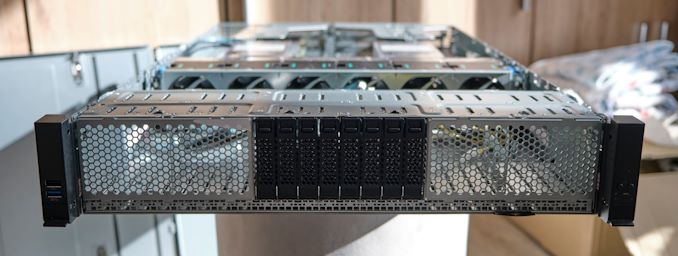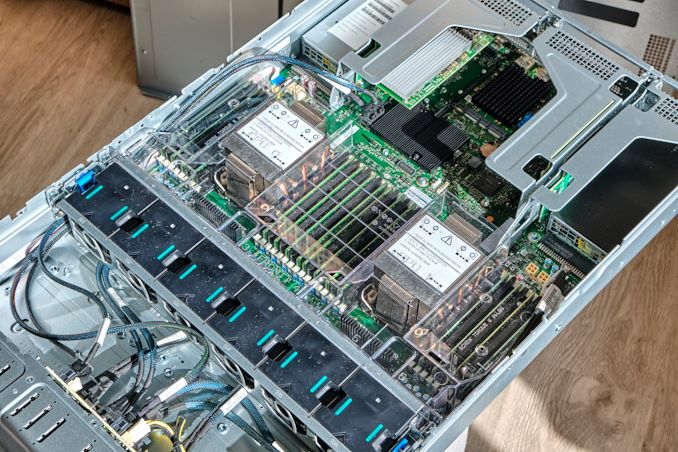Intel 3rd Gen Xeon Scalable (Ice Lake SP) Review: Generationally Big, Competitively Small
by Andrei Frumusanu on April 6, 2021 11:00 AM EST- Posted in
- Servers
- CPUs
- Intel
- Xeon
- Enterprise
- Xeon Scalable
- Ice Lake-SP
Test Bed and Setup - Compiler Options
For the rest of our performance testing, we’re disclosing the details of the various test setups:
Intel - Dual Xeon Platinum 8380
For our new Ice Lake test system based on the Whiskey Lake platform, we’re using Intel’s SDP (Software Development Platform 2SW3SIL4Q, featuring a 2-socket Intel server board (Coyote Pass).
The system is an airflow optimised 2U rack unit with otherwise little fanfare.
Our review setup solely includes the new Intel Xeon 8380 with 40 cores, 2.3GHz base clock, 3.0GHz all-core boost, and 3.4GHz peak single core boost. That’s unusual about this part as noted in the intro, it’s running at a default 205W TDP which is above what we’ve seen from previous generation non-specialised Intel SKUs.
| CPU | 2x Intel Xeon Platinum 8380 (2.3-3.4 GHz, 40c, 60MB L3, 270W) |
| RAM | 512 GB (16x32 GB) SK Hynix DDR4-3200 |
| Internal Disks | Intel SSD P5510 7.68TB |
| Motherboard | Intel Coyote Pass (Server System S2W3SIL4Q) |
| PSU | 2x Platinum 2100W |
The system came with several SSDs including Optane SSD P5800X’s, however we ran our test suite on the P5510 – not that we’re I/O affected in our current benchmarks anyhow.
As per Intel guidance, we’re using the latest BIOS available with the 270 release microcode update.
Intel - Dual Xeon Platinum 8280
For the older Cascade Lake Intel system we’re also using a test-bench setup with the same SSD and OS image as on the EPYC 7742 system.
Because the Xeons only have 6-channel memory, their maximum capacity is limited to 384GB of the same Micron memory, running at a default 2933MHz to remain in-spec with the processor’s capabilities.
| CPU | 2x Intel Xeon Platinum 8280 (2.7-4.0 GHz, 28c, 38.5MB L3, 205W) |
| RAM | 384 GB (12x32 GB) Micron DDR4-3200 (Running at 2933MHz) |
| Internal Disks | Crucial MX300 1TB |
| Motherboard | ASRock EP2C621D12 WS |
| PSU | EVGA 1600 T2 (1600W) |
The Xeon system was similarly run on BIOS defaults on an ASRock EP2C621D12 WS with the latest firmware available.
AMD - Dual EPYC 7763 / 7713 / 75F3 / 7662
In terms of testing the new EPYC 7003 series CPUs, unfortunately due to our malfunctioning Daytona server, we weren’t able to get first-hand experience with the hardware. AMD graciously gave us remote access to one of their server clusters – we had full controls of the system in terms of BMC as well as BIOS settings.
| CPU | 2x AMD EPYC 7763 (2.45-3.500 GHz, 64c, 256 MB L3, 280W) / 2x AMD EPYC 7713 (2.00-3.365 GHz, 64c, 256 MB L3, 225W) / 2x AMD EPYC 75F3 (3.20-4.000 GHz, 32c, 256 MB L3, 280W) / 2x AMD EPYC 7662 (2.00-3.300 GHz, 64c, 256 MB L3, 225W) |
| RAM | 512 GB (16x32 GB) Micron DDR4-3200 |
| Internal Disks | Varying |
| Motherboard | Daytona reference board: S5BQ |
| PSU | PWS-1200 |
Software wise, we ran Ubuntu 20.10 images with the latest release 5.11 Linux kernel. Performance settings both on the OS as well on the BIOS were left to default settings, including such things as a regular Schedutil based frequency governor and the CPUs running performance determinism mode at their respective default TDPs unless otherwise indicated.
AMD - Dual EPYC 7742
Our local AMD EPYC 7742 system, due to the aforementioned issues with the Daytona hardware, is running on a SuperMicro H11DSI Rev 2.0.
| CPU | 2x AMD EPYC 7742 (2.25-3.4 GHz, 64c, 256 MB L3, 225W) |
| RAM | 512 GB (16x32 GB) Micron DDR4-3200 |
| Internal Disks | Crucial MX300 1TB |
| Motherboard | SuperMicro H11DSI0 |
| PSU | EVGA 1600 T2 (1600W) |
As an operating system we’re using Ubuntu 20.10 with no further optimisations. In terms of BIOS settings we’re using complete defaults, including retaining the default 225W TDP of the EPYC 7742’s, as well as leaving further CPU configurables to auto, except of NPS settings where it’s we explicitly state the configuration in the results.
The system has all relevant security mitigations activated against speculative store bypass and Spectre variants.
Ampere "Mount Jade" - Dual Altra Q80-33
The Ampere Altra system we’re using the provided Mount Jade server as configured by Ampere. The system features 2 Altra Q80-33 processors within the Mount Jade DVT motherboard from Ampere.
In terms of memory, we’re using the bundled 16 DIMMs of 32GB of Samsung DDR4-3200 for a total of 512GB, 256GB per socket.
| CPU | 2x Ampere Altra Q80-33 (3.3 GHz, 80c, 32 MB L3, 250W) |
| RAM | 512 GB (16x32 GB) Samsung DDR4-3200 |
| Internal Disks | Samsung MZ-QLB960NE 960GB Samsung MZ-1LB960NE 960GB |
| Motherboard | Mount Jade DVT Reference Motherboard |
| PSU | 2000W (94%) |
The system came preinstalled with CentOS 8 and we continued usage of that OS. It’s to be noted that the server is naturally Arm SBSA compatible and thus you can run any kind of Linux distribution on it.
The only other note to make of the system is that the OS is running with 64KB pages rather than the usual 4KB pages – this either can be seen as a testing discrepancy or an advantage on the part of the Arm system given that the next page size step for x86 systems is 2MB – which isn’t feasible for general use-case testing and something deployments would have to decide to explicitly enable.
The system has all relevant security mitigations activated, including SSBS (Speculative Store Bypass Safe) against Spectre variants.
The system has all relevant security mitigations activated against the various vulnerabilities.
Compiler Setup
For compiled tests, we’re using the release version of GCC 10.2. The toolchain was compiled from scratch on both the x86 systems as well as the Altra system. We’re using shared binaries with the system’s libc libraries.












169 Comments
View All Comments
mode_13h - Wednesday, April 7, 2021 - link
Intel, AMD, and ARM all contribute loads of patches to both GCC and LLVM. There's no way either of these compilers can be seen as "underdeveloped".And Intel is usually doing compiler work a couple YEARS ahead of each CPU & GPU generation. If anyone is behind, it's AMD.
Oxford Guy - Wednesday, April 7, 2021 - link
It's not cheating if the CPU can do that work art that speed.It's only cheating if you don't make it clear to readers what kind of benchmark it is (hand-tuned assembly).
mode_13h - Thursday, April 8, 2021 - link
Benchmarks, in articles like this, should strive to be *relevant*. And for that, they ought to focus on representing the performance of the CPUs as the bulk of readers are likely to experience it.So, even if using some vendor-supplied compiler with trick settings might not fit your definition of "cheating", that doesn't mean it's a service to the readers. Maybe save that sort of thing for articles that specifically focus on some aspect of the CPU, rather than the *main* review.
Oxford Guy - Sunday, April 11, 2021 - link
There is nothing more relevant than being able to see all facets of a part's performance. This makes it possible to discern its actual performance capability.Some think all a CPU comparison needs are gaming benchmarks. There is more to look at than subsets of commercial software. Synthetic benchmarks also are valid data points.
mode_13h - Monday, April 12, 2021 - link
It's kind of like whether an automobile reviewer tests a car with racing tyres and 100-octane fuel. That would show you its maximum capabilities, but it's not how most people are going to experience it. While a racing enthusiast might be interested in knowing this, it's not a good proxy for the experience most people are likely to have with it.All I'm proposing is to prioritize accordingly. Yes, we want to know how many lateral g's it can pull on a skid pad, once you remove the limiting factor of the all-season tyres, but that's secondary.
Wilco1 - Thursday, April 8, 2021 - link
It's still cheating if you compare highly tuned benchmark scores with untuned scores. If you use it to trick users into believing CPU A is faster than CPU B eventhough CPU A is really slower, you are basically doing deceptive marketing. Mentioning it in the small print (which nobody reads) does not make it any less cheating.Oxford Guy - Sunday, April 11, 2021 - link
It's cheating to use software that's very unoptimized to claim that that's as much performance as CPU has.For example... let's say we'll just skip all software that has AVX-512 support — on the basis that it's just not worth testing because so many CPUs don't support it.
Wilco1 - Sunday, April 11, 2021 - link
Running not fully optimized software is what we do all the time, so that's exactly what we should be benchmarking. The -Ofast option used here is actually too optimized since most code is built with -O2. Some browsers use -Os/-Oz for much of their code!AVX-512 and software optimized for AVX-512 is quite rare today, and the results are pretty awful on the latest cores: https://www.phoronix.com/scan.php?page=article&...
Btw Andrei ran ICC vs GCC: https://twitter.com/andreif7/status/13808945639975...
ICC is 5% slower than GCC on SPECINT. So there we go.
mode_13h - Monday, April 12, 2021 - link
Not to disagree with you, but always take Phoronix' benchmarks with a grain of salt.First, he tested one 14 nm CPU model that only has one AVX-512 unit per core. Ice Lake has 2, and therefore might've shown more benefit.
Second, PTS is enormous (more than 1 month typical runtime) and I haven't seen Michael being very transparent about his criteria for selecting which benchmarks to feature in his articles. He can easily bias perception through picking benchmarks that respond well or poorly to the feature or product in question.
There are also some questions raised about his methodology, such as whether he effectively controlled for AVX-512 usage in some packages that contain hand-written asm. However, by looking at the power utilization graphs, I doubt that's an issue in this case. But, if he excluded such packages for that very reason, then it could unintentionally bias the results.
Wilco1 - Monday, April 12, 2021 - link
Completely agree that Phoronix benchmarks are dubious - it's not only the selection but also the lack of analysis of odd results and the incorrect way he does cross-ISA comparisons. It's far better to show a few standard benchmarks with well-known characteristics than a random sample of unknown microbenchmarks.Ignoring all that, there are sometimes useful results in all the noise. The power results show that for the selected benchmarks there is really use of AVX-512. Whether this is typical across a wider range of code is indeed the question...